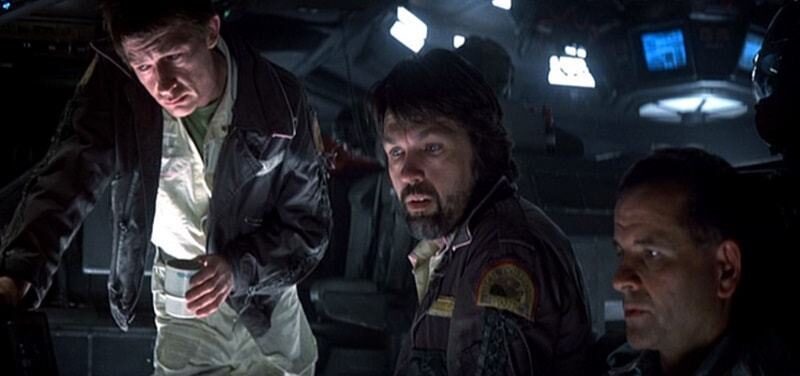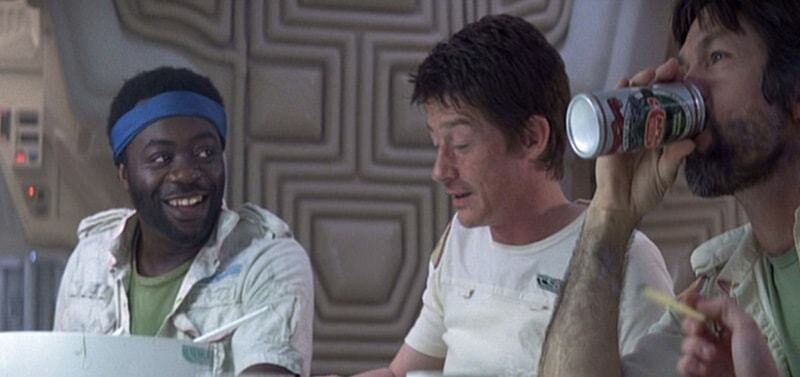Alien Anthology: A Revolution in Sci-Fi Costume Design | http://clothesonfilm.net – Part 15672

So much has been written about H.R. Giger’s justly-renowned xenomorph design that the human costume design in the Alien movies goes largely unnoticed, argues film critic Simon Kinnear. In the first of a two-part special, we revisit the saga on Blu-ray to look at just how important these costumes are in contextualising primal terror.
Traditionally, costume designers in science-fiction movies depicted the future as being utilitarian, uniform and very clinical: think of Forbidden Planet (1956) or 2001: A Space Odyssey (1968) for good examples of the space-faring look. The early 1970s saw a slight sea-change when Dark Star (1974), the John Carpenter film scripted by future Alien creator Dan O’Bannon, depicted space travel as a grubby, grimy business fit only for slackers. The break with 2001 was intentional, since the film is in part a satire of Kubrick’s vision, but it is also worth noting that Dark Star was a student film that got lucky; it was never intended to reach a wide audience.
Similarly, while in 1977 Star Wars’ rebels dress down, it is noticeable that George Lucas set his film “a long, long time ago,” all the better to associate the Jedi’s Kurosawa-inspired samurai robes and Han Solo’s low slung Western holster with more earthbound genres. Most futureshock visions of the era, however, stuck to the familiar generic template: look at Logan’s Run (1976) for a textbook example.
Alien, released in 1979, thus represents a real breakthrough. By rights, the crew of the Nostromo, working under the dead hand of corrupt corporation Weylan-Yutani, ought to be kitted out in regulation gear. But director Ridley Scott and costume designer John Mollo (fresh off Star Wars) followed the cues in O’Bannon’s story that, like truckers, these guys want to feel comfortable on their long haul mission.
The ‘lived-in’ look serves an important function in the overall psychological structure of the film, chiefly that the more familiar the crew appears, the more uncanny and unusual the alien will seem. Considerable attention has been spent on the extraordinary look created by artist H.R. Giger – an oily, metallic nightmare with a phallus-shaped head and layer upon layer of vicious incisors. It’s justly regarded as a design classic, but the interesting thing is that the Nostromo crew is already at war with its environment even before Kane (John Hurt) gives birth to the alien.
Frankly, the Nostromo is not a nice place to live and work. Below decks is a grimy, miserable murk, but their quarters are a sterile, science-lab limbo of gleaming white walls. So the crew personalises their living space with nodding-head toys, nudie pix and a cavalier disregard for cleaning up after themselves. There are so many beer cans lying around the place looks like a shrine to alcohol…although pay close attention, and you will notice the cans are branded with the Weylan-Yutani logo. Even in leisure, there is no escape.
That same tension is echoed in the compromise of the crew’s uniform. Everybody, it seems, must have a Nostromo badge sewn onto their shirt sleeve…but aside from that, they can wear what they like. Most striking are Brett (Harry Dean Stanton) and Parker (Yaphet Kotto), the below-decks worker drones who are bottom of the barrel in the ship’s hierarchy. Brett wears a Hawaiian shirt and baseball cap; Parker favours a sweatband.
The officer class dresses more conservatively, but still have their foibles. On the forthcoming Blu-ray release, it is impossible to miss the fraying edge of the jacket worn by Captain Dallas (Tom Skerritt). The suggestion is of a favourite piece of clothing, something familiar and meaningful he can take into the impersonal void of space.
Superficially, Ian Holm’s Ash (the traitor aboard the crew, an android programmed by Weylan-Yutani to bring back the alien eggs whatever the cost) looks no different. Same sewn-on badge, same personalised style – in his case, a short-sleeve blue shirt worn over a long-sleeved vest. But it is a disguise that Ash cannot quite pull off. His shirt is altogether starchier than his fellow crewmembers, because he’s not a career ‘trucker,’ instead having been assigned to the Nostromo at the last minute. The crispness of his grab reflects both his imposter’s position and the cold, clinical nature of his character.
As for Sigourney Weaver’s Ripley… the interesting thing here is that, in costume terms, her choice of (apparently regulation) overalls puts her closer to Ash than the accessorised ‘working class’ boys aboard ship, with whom she has an affectionately tetchy relationship. In the hierarchy of the ship, Ripley is a “suit,” the one crewmember who tries to insist on following procedure by quarantining Kane (John Hurt) after his alien attack.
Yet the longer the film goes on, the looser Ripley wears her clothes. Partly this is the practical result of Ash assaulting her when she discovers what’s going on, but partly it’s symbolic. Now that she has realised exactly what kind of people she’s working for, why bother with conformity? The transformation is completed in the film’s final scenes when, famously, Ripley strips down to her underpants. Any last adherence to Weylan-Yutani is cast aside; now Ripley is asserting her humanity (specifically, her overt femininity) in defiance of predatory alien and impersonal bureaucracy alike.
In Part 2, we look at how costume in the sequels develops these themes further. Alien Anthology is released on Blu-ray on 25th October. N.B: Image caps taken from DVD.
Simon Kinnear is a freelance contributor to Total Film and blogs about cinema at Kinnemaniac.
© 2010 – 2014, Lord Christopher Laverty.




